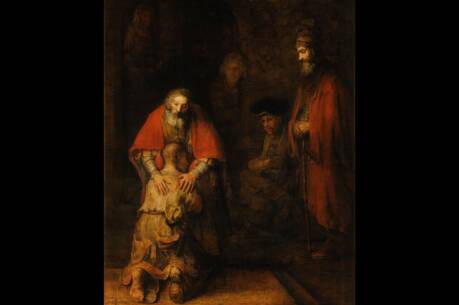Jesus does not walk alone, and neither should we
Palm Sunday of the Lord’s Passion is rich in symbolism, liturgical pageantry and an extra Gospel passage at the beginning of mass. This year the Sunday liturgies draw from cycle C readings, which highlight the Gospel of Luke. There are several elements in Luke’s account that are unique to the third Gospel. Any of these could be a center of reflection.
“A large crowd of people followed Jesus, including many women who mourned and lamented him” (Lk 23:27).
When have you stood with someone undergoing their own passion?
How will you walk with Jesus and your community during Holy Week?
In your prayer, how can you move from isolation to the communal way of the cross?
For example: Luke makes a strong association of the Christian Eucharist with the Jewish Passover meal. Luke also records an extensive farewell discourse of Jesus. Luke includes an appearance of Jesus before Herod and two separate incidents with Pilate. Only Luke recounts Jesus’ words to the penitent thief. Finally, Luke focuses more than the other evangelists on Jesus’ innocence.
To narrow down a single reflection on Luke’s passion account, it may be helpful to spend time with the Gospel’s insistence that Jesus does not go to death lonely and deserted. Great crowds follow him on the way to the cross. In addition, his disciples play a more decisive role in Luke’s account than in other Gospels. The crowds and disciples emphasize the role of discipleship in the passion narrative.
Peter and John, for example, fulfilled Jesus’ instructions to prepare the Passover meal. “I have eagerly desired to eat this Passover with you before I suffer,” said Jesus to his closest friends (Lk 22:15). Within this intimate group, the teacher offered several last instructions. He taught them, for example, that this final Passover meal provided him one last opportunity to be a servant to all (Lk 22:27). Then he said something tender, “It is you who have stood by me in my trials, and I confer a kingdom on you” (Lk 22:28-29). This part of the farewell discourse does not sound like the feelings of a person about to face a great tragedy alone. Rather, Jesus made a point to rally his community of disciples and remind them of their common bond: “You have stood by me.”
Immediately following the agony in the garden, Jesus was led away by the authorities for interrogation and trial. Peter, during the night, denied knowing his teacher three times at a public campfire outside of the house of the high priest. “The Lord turned,” writes Luke, “and looked at Peter,” who wept bitterly (Lk 22:61). The tension between the communal reality and the isolated experience of Jesus’ passion is on display within Peter’s weeping. Those tears come from a place of intimacy and companionship. In spite of Peter’s denial and his tears, he is still there in the courtyard waiting to see what happens next to his Lord and friend. Jesus walked a solitary path, but he was not alone.
If there is a truly lonely experience during Luke’s telling of the passion narrative, it is Jesus’ plea of innocence. Are there no other just ones to take up his cause? On the way of the cross, however, Luke describes believers and disciples following closely, subtly depicting a community “on the way” with Jesus. “A large crowd of people followed Jesus,” writes Luke, “including many women who mourned and lamented him” (Lk 23:27). Presented here, once again, was the communal nature of Jesus’ last moments, not alone and not entirely surrounded by mocking crowds, but also accompanied by those who mourned and lamented him.
Even on the cross, Luke presents Jesus with two thieves, one of them a righteous penitent criminal. The innocent one, Jesus, was crucified among the guilty and the righteous. Jesus was not alone since just ones walked with him and at least one justified criminal was crucified alongside him. Before Jesus died, he lamented with the words of the psalm, “Father, into your hands I commend my spirit” (Lk 23:46; Ps 31:6). The next line of Ps 31:6 transforms the lament into words of hope: “You will redeem me, Lord, God of truth.”
We can begin to view the passion of the Lord this Palm Sunday from a different lens. The solitary savior who goes to the cross alone and deserted is simply not present in Luke’s telling. At every point in Jesus’ passion and death, he is surrounded by those who weep, lament, beg for pardon and show their love. May we walk with Jesus on his way of the cross this Holy Week.








